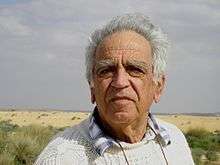Amotz Zahavi
| Amotz Zahavi | |
|---|---|
 Amotz Zahavi | |
| Born |
January 1, 1928 Petah Tikva, British Mandate of Palestine |
| Residence | Israel |
| Nationality | Israeli |
| Fields | Biology |
| Institutions | Tel Aviv University |
| Alma mater | Tel Aviv University |
| Known for | Handicap principle |

Amotz Zahavi (Hebrew: אמוץ זהבי) (born 1928 in Petah Tikva) is an Israeli evolutionary biologist, a Professor Emeritus at the Zoology Department of Tel Aviv University, and one of the founders of the Society for the Protection of Nature in Israel (known as the "SPNI"). His main works are in the evolution of signals, particularly those that indicate fitness, and their selection.
Biography
Amotz Zahavi received his Ph.D from Tel Aviv University in 1970. He is married to Avishag Zahavi, a biologist and a co-investigator.
Scientific career
Zahavi is best known for his work on the handicap principle, which explains the evolution of characteristics, behaviors or structures that appear contrary to the principles of Darwinian evolution in that they appear to reduce fitness and endanger individual organisms.[1] Evolved by sexual selection, these act as signals of the status of the organism, functioning to e. g. attract mates. He expanded it with theories on honest signalling and the idea that selection would favour signals that impose a higher cost, those that are not easily cheated on.
Awards
In 1980, Amotz Zahavi, together with the Society for the Protection of Nature in Israel and two other colleagues, was awarded the Israel Prize for SPNI's special contribution to society and the State, for the environment.[2]
In 2011, Amotz Zahavi received the International Fyssen Prize for the evolution of social communication; see [3]
In 2016, Amotz Zahavi received a prize for lifetime achievement from the Israel Society of Ecology and Environmental Sciences האגודה לאקולוגיה ולמדעי הסביבה ; see [4] (in Hebrew).
Published works
- Zahavi, A (1975). "Mate selection - a selection for a handicap". Journal of Theoretical Biology. 53 (1): 205–214. doi:10.1016/0022-5193(75)90111-3. PMID 1195756.
- Zahavi, A (1977). "The cost of honesty (Further remarks on the handicap principle)". Journal of Theoretical Biology. 67 (3): 603–605. doi:10.1016/0022-5193(77)90061-3. PMID 904334.
- Zahavi, A. and Zahavi, A. (1997). The handicap principle: a missing piece of Darwin's puzzle. Oxford University Press. Oxford. ISBN 0-19-510035-2
See also
References
- ↑ Zahavi, Amotz (1975). "Mate selection-A selection for a Handicap" (PDF). J Theor Biol. 53 (1): 205–214. doi:10.1016/0022-5193(75)90111-3. PMID 1195756.
- ↑ "Israel Prize Official Site - Recipients in 1980 (in Hebrew)".
- ↑ "International Fyssen Prize".
- ↑ רינת, צפריר (2016-06-15). "פרס מפעל חיים לפרופ' אמוץ זהבי על שמירת הטבע". הארץ (in Hebrew). Retrieved 2016-07-30.